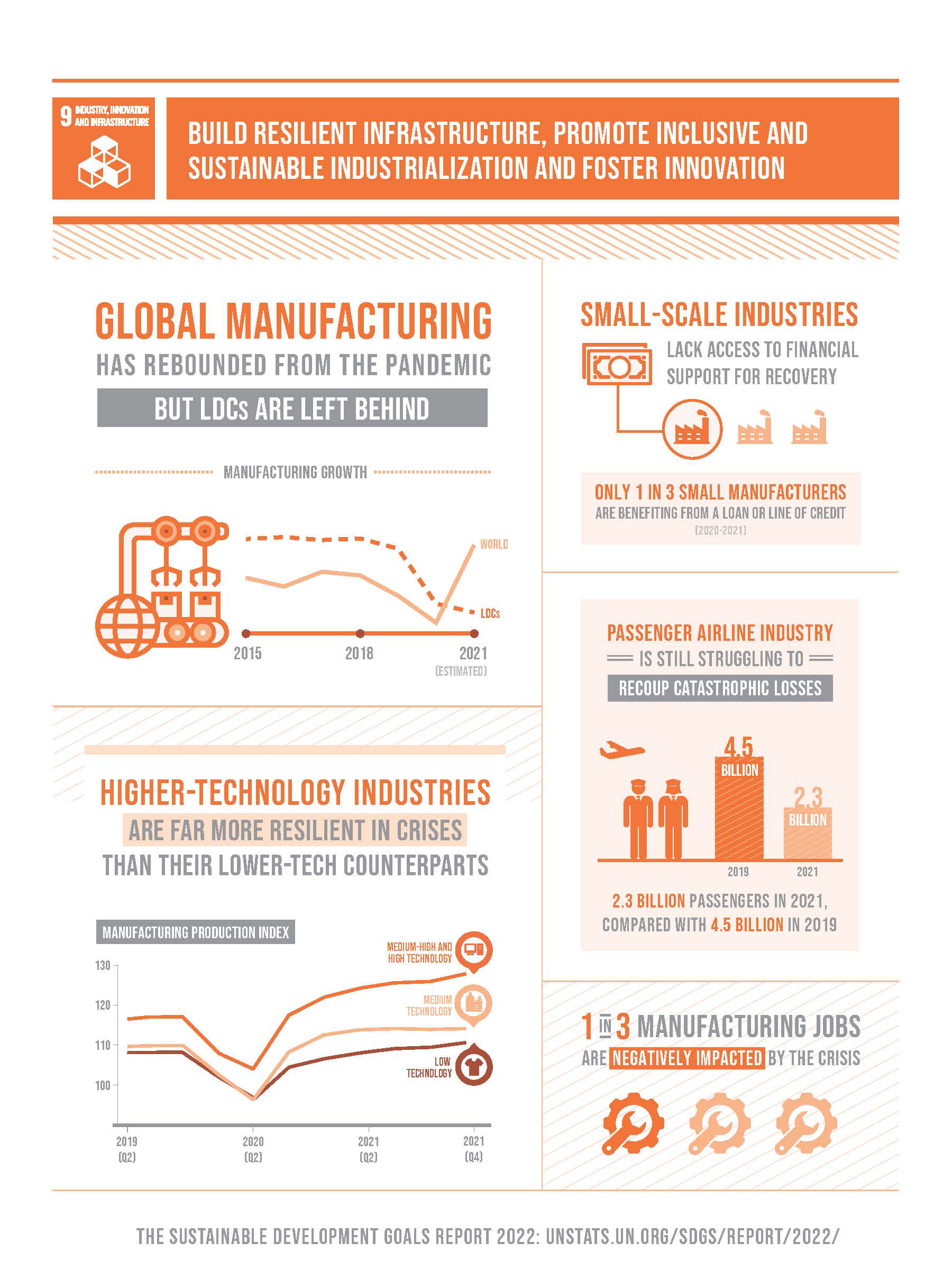Industries, Innovation and Infrastructure
Inclusive and sustainable industrialization, together with innovation and infrastructure, can unleash dynamic and competitive economic forces that generate employment and income. They play a key role in introducing and promoting new technologies, facilitating international trade and enabling the efficient use of resources.
However, the world still has a long way to go to fully tap this potential. Least developed countries, in particular, need to accelerate the development of their manufacturing sector if they are to meet the 2030 target, and scale up investment in scientific research and innovation.
Global manufacturing growth has been steadily declining, even before the outbreak of the COVID-19 pandemic. The pandemic is hitting manufacturing industries hard and causing disruptions in global value chains and the supply of products.
Innovation and technological progress are key to finding lasting solutions to both economic and environmental challenges, such as increased resource and energy-efficiency. Globally, investment in research and development (R&D) as a proportion of GDP increased from 1.5 per cent in 2000 to 1.7 per cent in 2015 and remained almost unchanged in 2017, but was only less than 1 per cent in developing regions.
In terms of communications infrastructure, more than half of the world’s population is now online and almost the entire world population lives in an area covered by a mobile network. It is estimated that in 2019, 96.5 per cent were covered by at least a 2G network.
The coronavirus pandemic has revealed the urgent need for resilient infrastructure. The Asian Development Bank notes that critical infrastructure in the region remains far from adequate in many countries, despite the rapid economic growth and development the region has experienced over the past decade.
The Economic and Social Survey of Asia and the Pacific highlights that making infrastructure resilient to disasters and climate change will require an additional investment of $434 billion per year. This sum may need to be even greater in some subregions, such as the Pacific small island developing states.
Sustainable Development Goals
The 2030 Agenda for Sustainable Development was adopted by all United Nations Member states in 2015, an agenda that provides a shared blueprint for peace and prosperity for people and the planet, now and into the future.
The 17 Sustainable Development Goals (SDGs) are an urgent call for action by all countries – developed and developing – in a global partnership. They recognize that ending poverty and other deprivations must go hand-in-hand with strategies that improve health and quality education, reduce inequality, and spur economic growth – all while tackling climate change and working to preserve our oceans and forests. Learn more about the UN SDG’s.

What’s the goal here?
To build resilient infrastructure, promote inclusive and sustainable industrialization and foster innovation.
Why?
Economic growth, social development and climate action are heavily dependent on investments in infrastructure, sustainable industrial development and technological progress. In the face of a rapidly changing global economic landscape and increasing inequalities, sustained growth must include industrialization that first of all, makes opportunities accessible to all people, and second, is supported by innovation and resilient infrastructure.
So what’s the problem?
Even before the outbreak of the COVID-19 pandemic, global manufacturing – considered an engine of overall economic growth – has been steadily declining due to tariffs and trade tensions. The manufacturing decline caused by the pandemic has further caused serious impacts on the global economy.
In addition, the airport industry, also an important driver of economic development, faced the steepest decline in its history in the first five months of 2020, with a 51 per cent drop in airline passengers due to the global lockdowns.
Basic infrastructure like roads, information and communication technologies, sanitation, electrical power and water remains scarce in many developing countries. In 2019, some 87 per cent of people in developed countries used the Internet, compared with just 19 per cent in the least developed countries.
How much progress have we made?
Investment in research and development globally – as well as financing for economic infrastructure in developing countries – has increased, and impressive progress has been made in mobile connectivity with almost the entire world population (97 per cent) living within reach of a mobile cellular signal.
Why should I care?
Inclusive and sustainable industrialization, together with innovation and infrastructure, can unleash dynamic and competitive economic forces that generate employment and income. They play a key role in introducing and promoting new technologies, facilitating international trade and enabling the efficient use of resources.
The growth of new industries means improvement in the standard of living for many of us. If industries pursue sustainability, this approach will have a positive effect on the environment.
What is the price of inaction?
The price is steep. Ending poverty would be more difficult, given the industry’s role as a core driver of the global development agenda to eradicate poverty and advance sustainable development. Additionally, failing to improve infrastructure and promote technological innovation could translate into poor health care, inadequate sanitation and limited access to education.
How can we help?
Establish standards and promote regulations that ensure company projects and initiatives are sustainably managed.
Collaborate with NGOs and the public sector to help promote sustainable growth within developing countries.
Think about how industry impacts on your life and well-being and use social media to push for policymakers to prioritize the SDGs.
United Nation Sustainable Development Goals
(United Nations why it matters)
Facts and Figures
- In 2018, 96 per cent of the world’s population lived within reach of a mobile-cellular signal, and 90 per cent of people could access the Internet through a third generation (3G) or higher-quality network.
- 16 per cent of the global population does not have access to mobile broadband networks.
- The global share of manufacturing value added in GDP increased from 15.2per cent in 2005 to 16.3per cent in 2017, driven by the fast growth of manufacturing in Asia.
- Least developed countries have immense potential for industrialization in food and beverages (agro-industry), and textiles and garments, with good prospects for sustained employment generation and higher productivity
- In 2019, the amount of new renewable power capacity added (excluding large hydro) was the highest ever, at 184 gigawatts, 20GW more than in 2018. This included 118GW of new solar systems, and 61GW of wind turbines.
- Capacity investment in solar slipped 3per cent to $131.1 billion in 2019, while that in wind climbed 6per cent to $138.2 billion – the first time that wind has outweighed solar in terms of dollars committed since 2010.
- Developing countries continued to outpace developed economies in renewables investment. In 2019, they committed $152.2 billion, compared to $130 billion for developed countries.
Goal 9 Targets
- 9.1 Develop quality, reliable, sustainable and resilient infrastructure, including regional and transborder infrastructure, to support economic development and human well-being, with a focus on affordable and equitable access for all
- 9.2 Promote inclusive and sustainable industrialization and, by 2030, significantly raise industry’s share of employment and gross domestic product, in line with national circumstances, and double its share in least developed countries
- 9.3 Increase the access of small-scale industrial and other enterprises, in particular in developing countries, to financial services, including affordable credit, and their integration into value chains and markets
- 9.4 By 2030, upgrade infrastructure and retrofit industries to make them sustainable, with increased resource-use efficiency and greater adoption of clean and environmentally sound technologies and industrial processes, with all countries taking action in accordance with their respective capabilities
- 9.5 Enhance scientific research, upgrade the technological capabilities of industrial sectors in all countries, in particular developing countries, including, by 2030, encouraging innovation and substantially increasing the number of research and development workers per 1 million people and public and private research and development spending
- 9.A Facilitate sustainable and resilient infrastructure development in developing countries through enhanced financial, technological and technical support to African countries, least developed countries, landlocked developing countries and small island developing States 18
- 9.B Support domestic technology development, research and innovation in developing countries, including by ensuring a conducive policy environment for, inter alia, industrial diversification and value addition to commodities
- 9.C Significantly increase access to information and communications technology and strive to provide universal and affordable access to the Internet in least developed countries by 2020
Links:
SG’s Strategy on New Technologies
UN Office for Disaster Risk Reduction
UN Industrial Development Organization
- How industrial development matters to the well-being of the population
- Industrial Development Report of UNIDO
- Industrialization As A Driver of Sustained Prosperity
International Telecommunication Union
UN Office for Project Services
International Civil Aviation Organization
We, at AI for Good foundation, are using AI + ML initiatives in pursuit of the 17 SDGs. With various projects in progress, such as our Climate Trend Scanner and the SDG Data Catalog, we are determined to help and facilitate achieving the goals.







